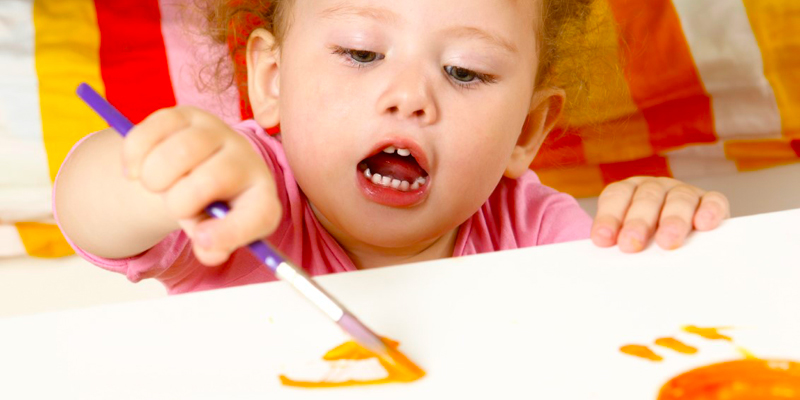
First Art Lessons: 4 Ways to Support Your Toddler’s Growing Interest in Creative Work
As your baby’s fine motor skills have grown, so has her ability to hold and use a greater variety of art materials. In addition, at 12-18 months old she better understands the idea that she can create these marks on a page with the movement of her arm and hand. What a discovery!1
(SPECIAL OFFER: Sign up for Playful Bee’s Bee Well developmental learning program to give your baby the best start in life. The first 10,000 children enroll for FREE! Sign up today.)
Let your baby explore her art on her own time and terms and continue exposing her to different creative mediums over time, such as craft dough, glue and tissue paper, and finger paint. When introducing her to a new material, model how to use it in order to show her how the tools are used and the beautiful colors and shapes she can create with them.2
Many children love the feeling of their art materials in their hands. However, for some children the sensory feedback may be too much.1 If she doesn’t initially enjoy the feeling of some of the materials, like craft dough or glue, that’s perfectly fine. Focus on the materials she does enjoy. You can try using them in new ways, such as letting her use her crayons on different types of papers. Or you can help her tear up and place colored paper for a collage while you are in charge of the glue. Later on, as she becomes more tolerant of the feel of the different materials, you can reintroduce them.
No matter how your baby feels about creating her own art, consider exposing her to the artwork of others, through books or museums.3 While looking at paintings or sculptures, talk about the subject of the work, how realistic (or not!) it is, and the colors or materials used. If your baby is drawn to a particular piece, you can make up a story about it (or tell her the real story behind it, if you know!). As she gets older and her imagination grows, she can be the one to tell you a story or to act out the scene pictured. If you’re at a museum, consider purchasing two postcards each of her favorite paintings to create a matching game to do at home. Or use these postcards to create an art scrapbook for your baby.
Play Tips:
Do you want to know how you can support your baby’s development of these Early Writing skills at this age? It’s easy! Read on for some simple tips to incorporate into your daily play time together.
- Offer a variety of art tools to experiment with.4 Give your baby different drawing, painting, and tactile art materials to explore, such as colored markers, sidewalk chalk, finger paints, and craft dough.
- Celebrate your baby’s artwork and her creative process.4 Show interest in her art and support her efforts and enthusiasm by proudly displaying her drawings, paintings, and other work for the entire family to see.
- Use non-toxic, washable versions of art materials. To avoid situations where your baby creates a permanent painting on your furniture or walls, be sure to purchase washable, non-toxic versions of art supplies. Consider placing her in a safe place that can be easily washed down afterwards, and keep an eye on her during art time, both to prevent messes and to make sure she doesn’t taste any of her art supplies!
- Highlight the artwork of others. If your baby doesn’t want to make art of her own, show her the art of others.2 This can be as simple as showing her a book of paintings or sculptures. You can also bring her to an art museum or make an art scrapbook together.
(SPECIAL OFFER: Sign up for Playful Bee’s Bee Well developmental learning program to give your baby the best start in life. The first 10,000 children enroll for FREE! Sign up today.)
Developmental Milestones:
Has your baby achieved the following Early Writing developmental milestones yet? If yes, check off all the skill(s) she has already mastered to date using Playful Bee’s developmental milestones tracker. It’s absolutely FREE and easy to use, just click HERE!
- Begins to show interest in using simple art materials appropriately.
Sources:
1Zero to Three. Learning to Write and Draw. Zero to Three: National Center for Infants, Toddlers, and Families. Retrieved December 22, 2013, from http://www.zerotothree.org/early-care-education/early-language-literacy/writing-and-art-skills.html.
2Crosser, Sandra. When Children Draw. Early Childhood News. Retrieved December 22, 2013, from http://www.earlychildhoodnews.com/earlychildhood/article_view.aspx?ArticleID=130.
3Danko-McGhee, Katherina and Shaffer, Sharon. Looking at Art with Toddlers. Smithsonian: Smithsonian Early Enrichment Center. Retrieved December 22, 2013, from http://www.si.edu/seec/resources.
4Maryland State Department of Education (2010). Healthy Beginnings: Supporting Development and Learning from Birth through Three Years of Age.
Playful Bee
Latest posts by Playful Bee (see all)
- Have a Super Fortune Cookie Friday! - February 9, 2018
- All Kinds of Shapes: Your Child Is Learning Simple Shapes, and Drawing Them Too! - November 13, 2017
- Fishing for Sneakers: Create your own Hand-Eye Coordination Fun - November 11, 2017

+ There are no comments
Add yours